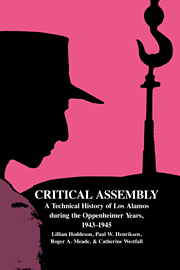Book contents
- Frontmatter
- Contents
- List of Illustrations
- Preface
- 1 Introduction
- 2 Early Research on Fission: 1933–1943
- 3 The Early Materials Program: 1933–1943
- 4 Setting Up Project Y: June 1942 to March 1943
- 5 Research in the First Months of Project Y: April to September 1943
- 6 Creating a Wartime Community: September 1943 to August 1944
- 7 The Gun Weapon: September 1943 to August 1944
- 8 The Implosion Program Accelerates: September 1943 to July 1944
- 9 New Hopes for the Implosion Weapon: September 1943 to July 1944
- 10 The Nuclear Properties of a Fission Weapon: September 1943 to July 1944
- 11 Uranium and Plutonium: Early 1943 to August 1944
- 12 The Discovery of Spontaneous Fission in Plutonium and the Reorganization of Los Alamos
- 13 Building the Uranium Bomb: August 1944 to July 1945
- 14 Exploring the Plutonium Implosion Weapon: August 1944 to February 1945
- 15 Finding the Implosion Design: August 1944 to February 1945
- 16 Building the Implosion Gadget: March 1945 to July 1945
- 17 Critical Assemblies and Nuclear Physics: August 1944 to July 1945
- 18 The Test at Trinity: January 1944 to July 1945
- 19 Delivery: June 1943 to August 1945
- Epilogue
- 20 The Legacy of Los Alamos
- Notes
- Name Index
- Subject Index
12 - The Discovery of Spontaneous Fission in Plutonium and the Reorganization of Los Alamos
Published online by Cambridge University Press: 31 March 2010
- Frontmatter
- Contents
- List of Illustrations
- Preface
- 1 Introduction
- 2 Early Research on Fission: 1933–1943
- 3 The Early Materials Program: 1933–1943
- 4 Setting Up Project Y: June 1942 to March 1943
- 5 Research in the First Months of Project Y: April to September 1943
- 6 Creating a Wartime Community: September 1943 to August 1944
- 7 The Gun Weapon: September 1943 to August 1944
- 8 The Implosion Program Accelerates: September 1943 to July 1944
- 9 New Hopes for the Implosion Weapon: September 1943 to July 1944
- 10 The Nuclear Properties of a Fission Weapon: September 1943 to July 1944
- 11 Uranium and Plutonium: Early 1943 to August 1944
- 12 The Discovery of Spontaneous Fission in Plutonium and the Reorganization of Los Alamos
- 13 Building the Uranium Bomb: August 1944 to July 1945
- 14 Exploring the Plutonium Implosion Weapon: August 1944 to February 1945
- 15 Finding the Implosion Design: August 1944 to February 1945
- 16 Building the Implosion Gadget: March 1945 to July 1945
- 17 Critical Assemblies and Nuclear Physics: August 1944 to July 1945
- 18 The Test at Trinity: January 1944 to July 1945
- 19 Delivery: June 1943 to August 1945
- Epilogue
- 20 The Legacy of Los Alamos
- Notes
- Name Index
- Subject Index
Summary
During the spring of 1944, Emilio Segrè's group in P-Division made the startling observation that the first samples of pile-produced 239Pu had an unusually high spontaneous fission rate, with a neutron emission approximately five times that of cyclotron-produced 239Pu. This finding confirmed the gnawing suspicions of Fermi, Segrè, Seaborg, and others that the neutron bath in the production piles at Clinton and Hanford might cause the formation of a significant quantity of 240Pu, an as-yet-unobserved spontaneously fissioning isotope of plutonium. However, the alarmingly high rate of the spontaneous fission was unexpected. This rate increased the neutron background enough to make it highly probable for a gun-assembled gadget to predetonate and thus undermined the plutonium gun program.
Determined not to lose the heavy investment made in plutonium production, Groves forced the laboratory to change course. The primary technical objective shifted from developing a gun weapon to developing a plutonium implosion assembly. Within days after Oppenheimer officially announced the spontaneous fission discovery, the laboratory reorganized its work force to focus on implosion. Two new divisions were established – X (Explosives) under Kistiakowsky, and G (Gadget) under Bacher. Most of the groups in these new divisions were moved out of the earlier Research and Ordnance Engineering divisions. Unfortunately, at this point experiments in the implosion diagnostic program were indicating that an implosion weapon would be extremely difficult, if not impossible, to achieve.
- Type
- Chapter
- Information
- Critical AssemblyA Technical History of Los Alamos during the Oppenheimer Years, 1943–1945, pp. 228 - 248Publisher: Cambridge University PressPrint publication year: 1993

